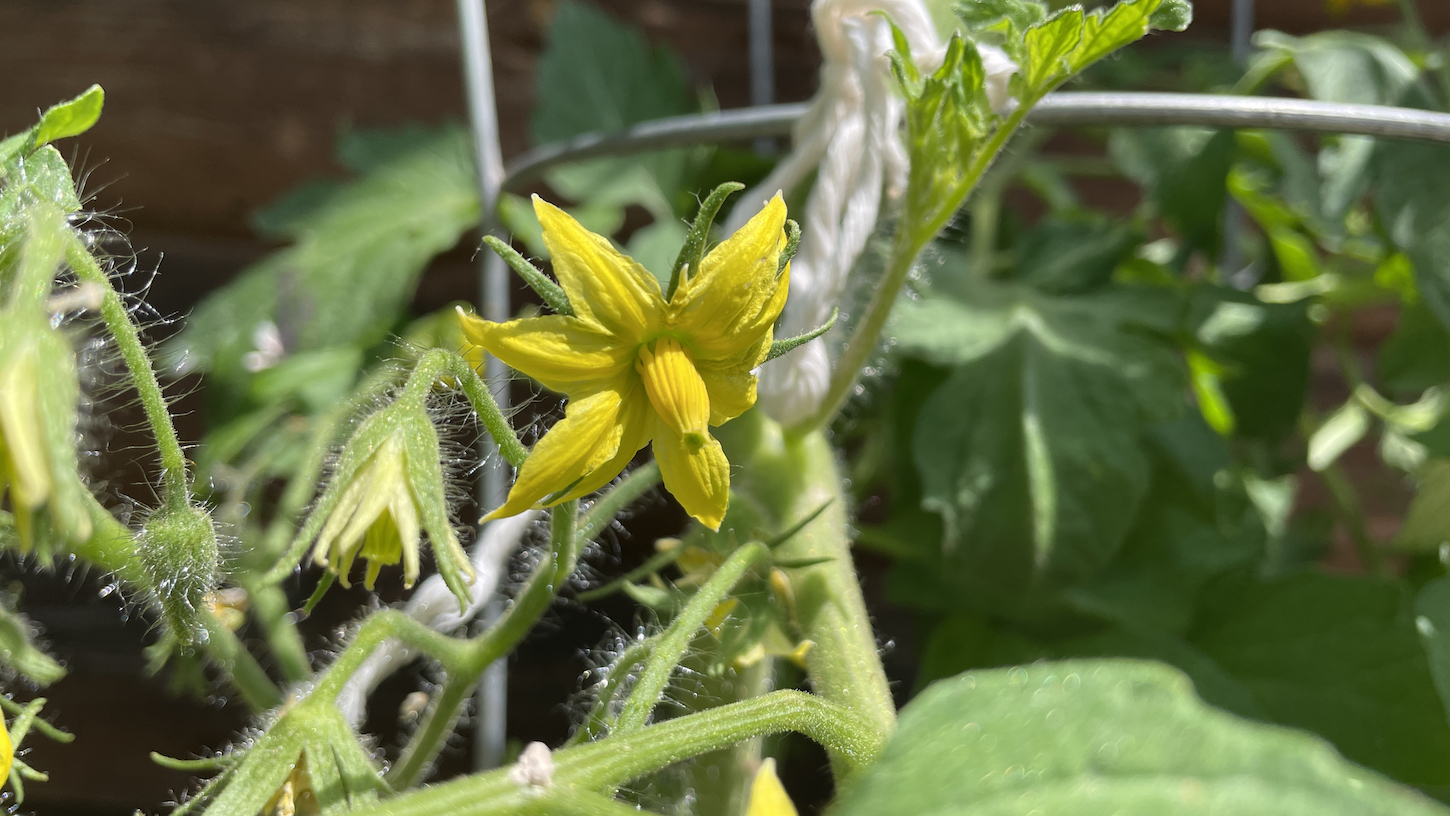I was in New York basically all last week, attending Defector Small Business Owner Job Creation Backbone Of American Economy meetings, offering awkward hellos to our two very nice and talented young interns, and riding the Staten Island Ferry because I like doing that. This was all very fun and nourishing, but also mildly stressful, and not only because I am very easily overwhelmed by the work of simply getting from here to there in an environment about as different from my forest hermitage as it can be. Also: Being away for a week meant leaving my little container garden largely unfussed-over!
Container gardening is a little tricky; it demands some fussing. I say this not to flatter my expertise—I have none—but because it's true. The plants can't reach groundwater, for one thing, so they need more regular watering than stuff planted in the actual ground. The south- and west-facing sides of pots, and thus the soil those pots contain, can get alarmingly hot on a sunny afternoon, which can quite simply bake the roots of your poor plants if you do not relieve them with a drink of cool water. Speaking of the soil, since the plants only have access to a small, fixed quantity of that, they can deplete it of nutrients relatively quickly, so you have to fertilize or add compost or whatever.
The trade-off that makes this worth it for me in particular is that, by planting stuff in pots, I can raise them on a south-facing, sun-drenched part of my deck inaccessible to deer, groundhogs, and industrious chipmunks, who otherwise will eat all of my delicious harvestable foods. (Also, not for nothing, but the most garden-friendly strip of land in my wooded homestead also happens to have been treated with termite poisons; nothing that grows there, I'm told, will be safe for human consumption.) And I've generally had great results over six or seven years of gardening this way, though at least one summer I got slack on feeding the soil and my tomatoes came out depressingly bland and hard. Not the point!
Late May is a tough time to leave the garden unfussed-over for a week. The plants, particularly the tomatoes, are growing at furious rates, but the weather is extremely moody and unpredictable. They might get an overcast week of rain and humidity, or a week of searing heat and constant sunshine, or any mix of both. This was very much on my mind when I planned this year's container garden: It's why I scaled back my ambitions this year to two tomato plants and a quartet of herbs, less than half as many plants as I took on a year ago. And it was also on my mind all through the New York trip, because what if I came back and the tomato plants were just a bunch of withered brown sticks!
I'm happy to report that's not the case. All the plants survived, and at least a couple of them are looking fantastic, if I may say so, which I may, because it is my website. (Two of them look like shit. But they're alive!) Here is a Garden Check.
Tomato Plant No. 1
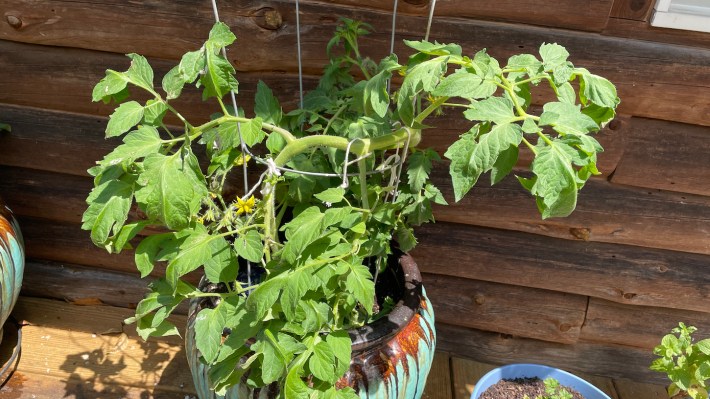
A beauty! This indeterminate baby will grow beefsteaks. I'm training it to spiral up that wire cage so that it won't have to fight gravity so hard to get water to any tomatoes growing farther from the soil. Tomato plants are very thirsty, and these huge ceramic pots heat up dramatically in the afternoon; this guy gets a gallon of cool water in the morning and then another gallon at the peak of the day's heat, just to cool the soil down. Also it gets some organic tomato fertilizer sorta tilled into the top layer of its soil once a month.
Tomato Plant No. 2
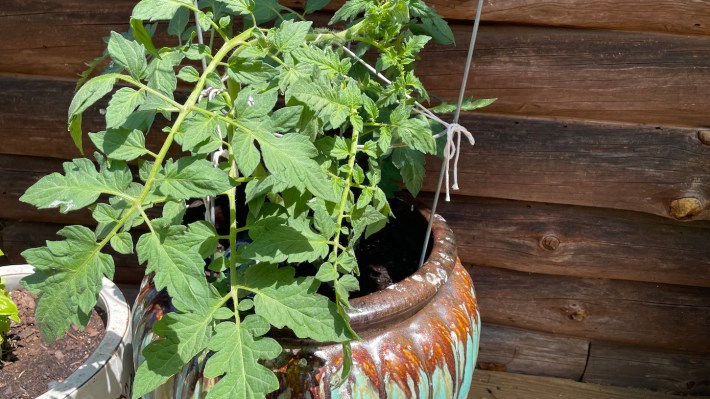
This fella is another indeterminate variety; it'll grow something called "Better Boy" tomatoes that are basically just big red tomatoes. It's looking very good, and is clearly a very healthy plant, but it isn't bursting with flowers yet; in fact its first spray of flowers is like 18 inches up from the base of the stem, which is kind of annoying. At any rate I'm working on training this guy to spiral up the cage like the bigger beefsteak plant, which sits right next door as a source of motivation. Like its buddy, this one gets a gallon in the morning and another when it's hot as hell in the afternoon, and the same fertilizer deal.
Basil
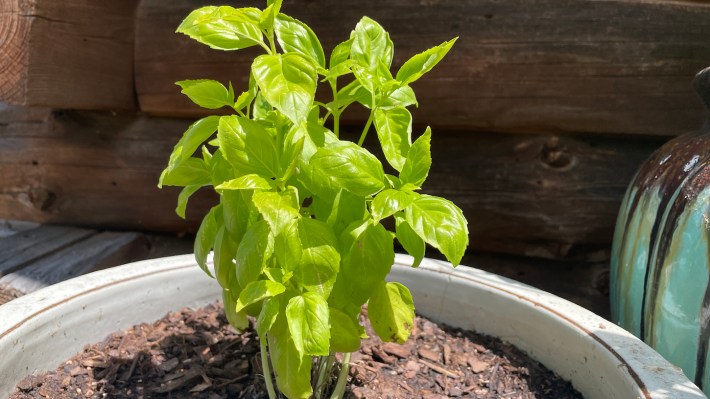
Pretty good, but only pretty good. Basil and poblano peppers were the first two types of food-plant I ever grew, starting around 15 years ago, and I always had great luck developing gigantic, endlessly prolific bushes of basil until a couple of years ago, when suddenly all of my baby basil plants were developing root-rot and dying. So I am thrilled with this little buddy, even if it's yellower than I'd like and not exactly rocketing upward from the soil. It's alive, is the thing.
Basil is particularly sensitive to hot soil, which it interprets as a sign that the "getting enough water to live" part of the year has ended; this triggers bolting, when the plant grows flowers and its stalk turns woody and its leaves lose their aroma and flavor. So whether it's all that thirsty or not, it gets a deep drink of cool water in the hot afternoon to lower its temperature; this pot-and-soil combination drains really super well, so that I don't have to worry about overwatering and the dreaded root-rot. Soon, in theory, I will start regularly harvesting the topmost groups of leaves, to discourage bolting and to encourage growing nice big leaves. But it doesn't look ready for that yet. Look how little it is!
Now we are getting to the couple of plants that don't look good.
Parsley
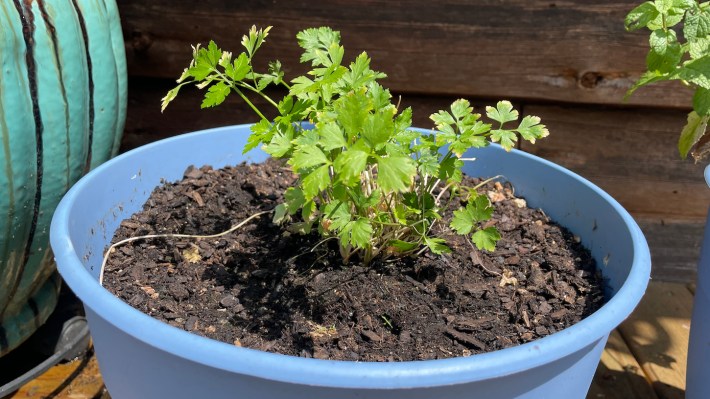
I grow parsley basically every year, because it is super easy and because the homegrown stuff is so much more potent than what's available at the store; three measly leaves are enough to add fragrance to an entire family-sized meal. Typically I have planted it in an old wooden ice bucket that I drilled some holes through and repurposed as an herb planter, but this year I planted it in this deep rubber pot, and was excited about the idea of my parsley plant having a lot more soil beneath it. Maybe it would be healthier, and bigger, and more resistant to drought! Alas, I found out too late that this pot drains really, really poorly, bordering on not at all; by the time I discovered this, a full day after a really heavy rain, the poor parsley plant had nearly drowned.
I drilled a wide hole at the bottom of the pot to improve drainage, but the water that came out was stinky, a bad sign. Within a day just about every one of the parsley stems had yellowed and gone noodly. The improved drainage has allowed the poor guy to survive, as you can see, but it's not a pretty sight. I'm not gonna give up on it.
Oh hey, speaking of the disappointing rubber pots.
Earth's Only Shabby Peppermint

It really takes some doing—or a really incredible lack of doing—to fuck up a peppermint plant, but the drainage failure nearly killed this guy, too. Look at how shitty it looks! It's leaning away from the sun. I've never seen that, and I hate it. This is by far the least healthy peppermint plant I've ever had; for that matter, it's the only peppermint plant I've ever had that wasn't bursting out of its pot and trying to colonize the earth. But! It's alive. And so I'm gonna keep fussing over it, and see what I get.
This has been Garden Check. What are you growing, and how is it doing?
